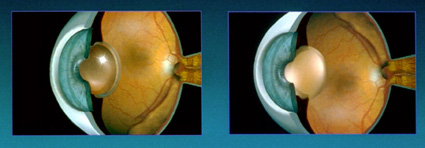All About Cataracts
One of the most common problems which can affect vision is a cataract. The most common type is related to aging. Almost everyone who lives a long life will eventually develop cataracts.
In the early stages, stronger lighting and eyeglasses may lessen vision problems caused by cataracts. At a certain point, however, surgery may be needed to improve vision.
What is a Cataract?

A cataract is not a film over the eye. A cataract occurs when the lens becomes frosty - just like a frosty windshield in a car. The lens is made mostly of water and protein. The protein is arranged to let light pass through and focus on the retina. Sometimes some of the protein clumps together. This can start to cloud small areas of the lens, blocking some light from reaching the retina and interfering with vision.
In its early stages, a cataract may not cause a problem. The cloudiness may affect only a small part of the lens. However, over time, the cataract may grow larger and cloud more of the lens, making it harder to see. Because less light reaches the retina, your vision may become dull and blurry. A cataract won't spread from one eye to the other, although many people develop cataracts in  both eyes. both eyes.
If there is any problem with the retina,
this can limit the usefulness of cataract surgery because the retina itself is like the
film in a camera, and if you have bad film, it does not matter what camera you put it in,
you have difficulty getting a good picture.
If the only problem with the eye is to do with the frosty lens, then there is an excellent chance that vision can be restored by having a cataract operation to remove the cataract, along with the intraocular lens implant which is meant to replace the focusing power that is lost with removal of the lens during a cataract operation.
|

 both eyes.
both eyes.